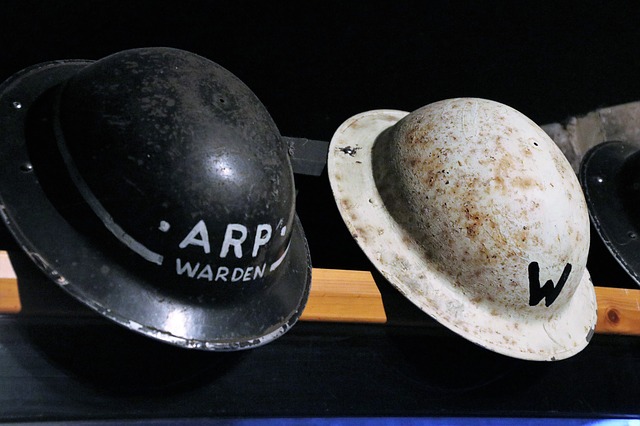By Tim Lambert
When the Second World War began on 3 September 1939 it was feared that the Germans would bomb British cities causing great loss of life. So children from British cities were evacuated to the countryside. Altogether 827,000 schoolchildren with 103,000 teachers and helpers left the big cities. Furthermore, 524,000 children below school age and their mothers left. However, most of the ‘evacuees’ soon returned home. The bombing raids on British cities did not begin till the summer of 1940.
Air Raids in the Second World War
Before the war, the British government began preparing for air raids. By 1939 they had an air raid precautions system ready with barrage balloons and air raid sirens. Before the war began people bought Anderson shelters (although poor people could get them free). An Anderson shelter was made of sections of corrugated iron. You erected it in a hole at least 3 feet deep in your garden and used the earth from the hole to cover it.
From the end of 1940, some people got Morrison shelters (again poor people could get them free). The Morrison shelter was a steel cage you erected indoors. In London, some people sheltered in tube stations.
On 7 September 1940, the Germans began bombing London and by 1 January 1941 over 13,000 Londoners were killed. Other cities heavily bombed in 1940-1941 included Birmingham, Coventry, Bristol, Portsmouth, and Plymouth. The period of bombing from September 1940 to May 1941 is sometimes called The Blitz.
During The Blitz crime greatly increased. All recorded crimes increased 57% and there were many cases of looting.
In June 1944 the Germans unleashed a ‘secret weapon’ on Britain. It was a kind of rocket called a VI flying bomb. (The British public called them ‘doodlebugs’). From September 1944 V2 rockets were launched. altogether 1,115 V2s hit England and about half of them hit London. The last V2 was fired on 27 March 1945. At first, the British government claimed the explosions were caused by exploding gas mains (which didn’t fool anybody!). They did not admit the truth until November 1944. Hitler called his new weapons vengeance weapons yet the German bombing failed. It failed to dent British morale and it failed to seriously affect industrial output.
About 1 million houses in Britain were destroyed or severely damaged during the Second World War. About 40,000 civilians were killed. After the war, Britain was left with a severe shortage of housing.

Rationing in Britain in the Second World War
Rationing in Britain began in September 1939 when petrol was rationed. As the war continued rationing became stricter and stricter. In January 1940 butter, sugar, bacon, and ham were rationed. Tea was rationed from July 1940. From March 1941 jam and marmalade were rationed. Then in May 1941 cheese was rationed and from June 1941 eggs were rationed. From November 1941 milk was also rationed.
Rationing became more severe in 1942. From July 1942 sweets were rationed.
Instead of real eggs, many people had to make do with ‘dried eggs’ imported from the USA. (They were a powder to which you added water and many people said they tasted horrid!).
The amount of food you were allowed varied during the war. However, you were typically allowed 3 pints of milk a week (sometimes only 2). You were allowed 1 egg a week (sometimes 1 every 2 weeks), 50g of tea, and 225g of sugar. You were also allowed 350g of sweets every 4 weeks.
During the Second World War, the people were encouraged to ‘dig for victory’ and the amount of land under cultivation increased from 12 million acres in 1939 to 18 million acres in 1945.
From July 1941 clothes were also rationed. You had to save up coupons to buy your clothes. During World War II it was necessary to save material so skirts were shorter. People were encouraged to make do and mend.
Women did not wear tights at that time (they were not invented until 1958). However, they did wear stockings but they were scarce so some women tanned their legs brown and painted a seam on! Clothes were rationed until 1949.
Other Rationing
In 1940 only about 1 family in 10 in Britain owned a car. Most people relied on buses and trains. At first petrol for cars was rationed. However, in 1942 it was stopped altogether!
Many things were in short supply or unavailable even if they were not rationed and queuing became part of British life. There were no bananas in Britain during the Second World War as they had to be imported from abroad. Most toy factories were converted to making things for the war so children had to make do with old toys or make their own from pieces of cloth or wood.
From February 1941 soap and washing powder were rationed and even saucepans were very difficult to come by.
Entertainment in the Second World War
In Britain television started in 1936. However, it stopped during the Second World War. In any case, very few people owned a TV in 1939. However, most people had a radio though and it was vital to keep up morale and keep people informed. Since people did not have a TV. going to the cinema was very popular. Most people went to the cinema at least once a week and many people went twice. There were, of course, far more cinemas than there are today.
Women in the Second World War
Women played a vital role in Britain during the Second World War. They operated anti-aircraft guns and worked as ambulance drivers. Many joined the services as wrens (navy) or waafs (air force). Other women joined the Auxiliary Territorial Service (ATS). Some women worked in factories or on farms as part of the women’s land army. There were also dustwomen and female postal workers. Many women were nurses and there was a women’s auxiliary fire service. Women were also ARP wardens.